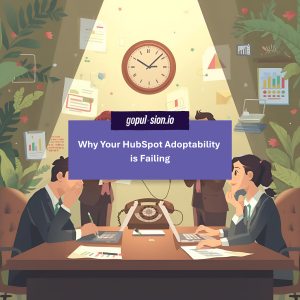 Executives invest in HubSpot expecting instant transformation. After all, it’s a best-in-class CRM and marketing platform. Yet walk into many mid-market companies and you’ll hear the same complaint: “Our sales team isn’t adopting the CRM.” Deals slip through cracks, dashboards remain generic, and leadership wonders whether HubSpot was the right choice in the first place.
Executives invest in HubSpot expecting instant transformation. After all, it’s a best-in-class CRM and marketing platform. Yet walk into many mid-market companies and you’ll hear the same complaint: “Our sales team isn’t adopting the CRM.” Deals slip through cracks, dashboards remain generic, and leadership wonders whether HubSpot was the right choice in the first place.
The truth is uncomfortable but simple: HubSpot doesn’t fail on its own. Adoptability fails when leadership expects the out-of-the-box setup to fit perfectly.
Default Settings Don’t Work For Most Organizations
When sales reps log into HubSpot and see pipelines that don’t reflect reality, dashboards that feel irrelevant, and fields they don’t understand, disengagement is inevitable.
Pipelines often remain stuck on the factory defaults, “Appointment Scheduled,” “Contract Sent,” “Closed Won.” For many B2B sales processes, those stages simply don’t match how deals flow.
The same problem happens with contact types and lead statuses. Without tailoring, “Qualified” or “Unqualified” is too vague to be useful. Reps either ignore updates or invent their own workarounds, leaving the CRM fragmented. Dashboards add another layer of friction. Executives want forecasts and revenue projections; reps want call lists and daily activity tracking. Without both, neither group finds HubSpot valuable.
Adoptability Requires Customization
What drives HubSpot usage isn’t more training, it’s a system that feels intuitive, and that reflects your teams actual workflow. Customization is the difference between frustration and daily reliance. Even small changes create a disproportionate impact.
A 2025 HubSpot report found that companies customizing deal pipelines to match real-world stages saw 37% higher adoption rates across their sales teams. That number jumps even higher when dashboards are configured for both reps and executives, rather than forcing one view on everyone.
This doesn’t require a massive rebuild. It’s about tailoring the basics:
- Pipeline stages that match your actual process.
- Contact properties that reflect how leads move through marketing and sales.
- Dashboards that provide value to both managers and reps.
When HubSpot reflects how a team actually works, adoptability ceases to be a fight.
Automation: The Overlooked Secret
The biggest irony in failed HubSpot adoption is how often automation is ignored. Many companies use HubSpot like a glorified spreadsheet, manually updating, assigning, and reminding. But HubSpot was built to remove that burden.
Simple workflows like auto-assigning new leads, sending nudges for stagnant deals, or triggering post-meeting follow-up emails can transform perception. Salespeople stop seeing HubSpot as an admin chore and start seeing it as an assistant. When the platform saves time instead of taking it, adoption accelerates.
Alignment Between Marketing and Sales
CMOs should care about HubSpot adoptability as much as sales leaders do. Without consistent usage, marketing attribution collapses. Lead sources get murky, ROI becomes guesswork, and the credibility of campaigns is undermined.
HubSpot’s 2025 State of Marketing showed that 71% of companies aligning sales and marketing within the platform improved lead-to-customer conversion. Adoptability is not just a technical issue, it’s a revenue issue.
Leadership Sets the Tone
One of the most damaging behaviors executives model is detachment. When leaders never log into HubSpot, reps conclude it isn’t important. Adoption thrives when managers and executives use dashboards for performance discussions, reference HubSpot data in meetings, and lead by example. The culture of usage starts at the top.
The Cost of Poor Adoptability
McKinsey (2025) estimates that mid-market firms lose 12-18% of potential revenue annually due to poor CRM adoption. That loss doesn’t show up as a single line item; it hides in missed follow-ups, inaccurate forecasts, and sales cycles that stall. The hidden cost of poor HubSpot adoption is not the subscription fee, it’s the lost growth opportunity.
Reframing HubSpot as Infrastructure
The most successful mid-market companies treat HubSpot like infrastructure, not software. Just as finance runs on ERP systems, revenue teams run on CRM. That shift in perspective reframes customization and automation as non-negotiable, not optional.
Adoptability, then, becomes a measure of operational health. If sales teams aren’t using HubSpot, the issue isn’t training or resistance, it’s leadership failing to create a system designed for them.
Adoption is Built, Not Bought
HubSpot doesn’t fail companies. Companies fail HubSpot when they expect the default experience to fit. Adoptability is earned through customization, automation, alignment, and leadership example.
The ROI is clear: better forecasting, improved marketing attribution, faster deal cycles, and revenue growth. The alternative is wasted investment and fractured teams.
If your HubSpot implementation is underperforming, the solution is not abandoning it, it’s optimizing it. And that’s where we come in.
Visit gopulsion.io. As a Google Award-winning agency, we help companies customize HubSpot to achieve real adoption, integrate it with campaigns, and turn CRM into a true growth engine.